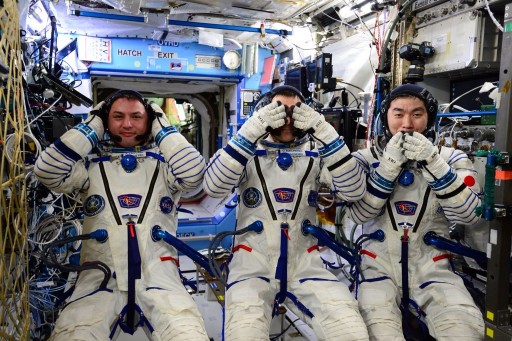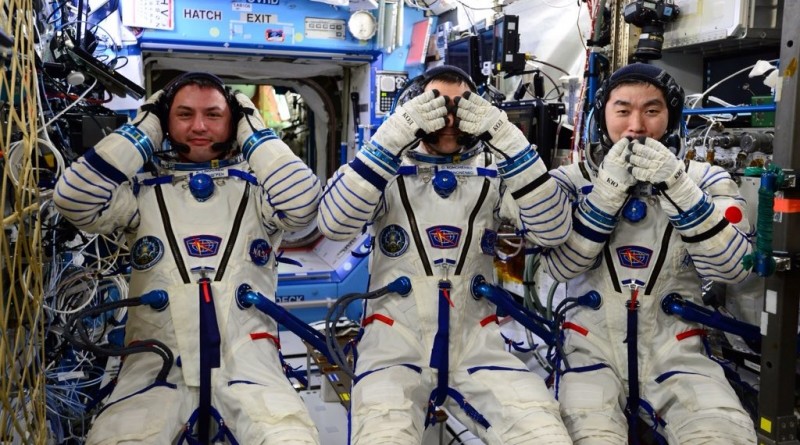ISS Operations Update – December 2, 2015

Experiments:
Biochemical Profiles [The Biochemical Profiles study obtains blood and urine samples from long-duration space travelers before, during and after space flight to monitor specific proteins and chemicals that act as biomarkers and allow an assessment of particular biological, biochemical, biophysical processes that affect the health of a human. Conducting frequent sampling allows for the generation of a database of samples and test results which allows scientists to study the effects of spaceflight on the physiology of humans and it also allows an assessment of countermeasures associated with exercise and nutrition. The experiment consists of eight in-flight sessions comprised of a fasting blood draw and 24-hour urine collection. Body mass measurements on a monthly basis are also evaluated as part of the study.]
Ocular Health – Optical Coherence Tomography, Fundoscope Measurements [OH is a human physiology study. Its full name is Prospective Observational Study of Ocular Health in ISS Crews. “The Prospective Observational Study of Ocular Health in ISS Crews (Ocular Health) protocol aims to systematically gather physiological data to characterize the Risk of Microgravity-Induced Visual Impairment/Intracranial Pressure on crewmembers assigned to a 6 month ISS increment,” the NASA experiment overview said. It is known that some (not all) astronauts in orbit experience changes in visual acuity (visual clarity) and intraocular pressure as a result of fluid shifts within the body as it is subjected to microgravity. About 20% is astronauts flying to ISS have reported these kinds of changes. Test subjects will undergo pre-flight, flight and post-flight testing of their eyes using a variety of techniques.]
VEG-01 Investigation – Plant Watering [VEGGIE or Veg-01 is a deployable plant growth unit to be set up on the Space Station to demonstrate the feasibility of a space garden. The experiment facility provides lighting and nutrient supply and is capable of supporting a variety of plant species that can be cultivated for educational outreach, fresh food and even recreation for crewmembers on long-duration missions. Thermal control is provided from ISS in-cabin systems and the carbon dioxide source is the ambient air aboard ISS.]
Saliva Sample Collection for Kelly Twins Study
Sleep ISS-12 [The ISS-12 experiment monitors the ambient light exposure and crew member activity and collects data on the subjective evaluation of sleep and alertness. Ambient light and activity are monitored via a wrist-worn actiwatch that delivers actiwatch spectrums that are put through bio-mathematical models of sleep and light to predict circadian phase. Sleep logs will be kept by crew members as a subjective assessment of sleep quality and duration. It is hoped that this investigation can deliver requirements for lighting, sleep-shifting protocols and workloads for future space exploration missions.]
Habitability Experiment Ops [Assessment of International Space Station Vehicle Habitability will see teams on the ground study video of the behavior of crew members within the habitable environment of ISS while the crew fills out questionnaires and collects video of areas of interest in order to provide an assessment of the habitability of ISS in its current state for a one-year mission. Results will be used to develop spacecraft with improved habitability properties to allow crew members to optimally utilize the onboard space.]
Microbiome [The study will investigate the impact of long duration space flight on both, the human immune system and an individual’s microbiome. The microbiome is the totality of microbes that live in and on the human body at any given time and influence human physiology. Some consider the microbiome to be a “newly discovered organ” due to its importance for human physiology. In fact, there are about 10 times more microbial cells than human cells in and on the human body, but the microbiome only accounts for about 200 grams.]
Vzir Experiment Operations and Tagup [Vzir (Viewfinder) uses the SKPF-U (Photo Image Coordinate Reference System) hardware, a photo image coordinate reference system using ultrasound sensors and a camera for general target views.]
EXPOSE-R Data Transfer [The EXPOSE payload platform was developed by the European Space Agency to conduct astrobiology studies by exposing samples and experiments to the space environment – mounting the platforms on the exterior of ISS for an extended period of time before retrieving them for return to Earth. The effects of the space environment (increased UV exposure, cosmic radiation, microgravity, atomic oxygen, temperature variations) on organic matter and organisms have been heavily studied via space-based experiments and in ground-based laboratory simulations. These studies are performed to better understand the role of interstellar, cometary and planetary chemistry with respect to prebiotic molecules leading to the formation and evolution of life on Earth, also assessing the possibility of its distribution in space. EXPOSE experiments in the past exposed solid materials, gas mixtures, and biological samples to the space environment to simulate conditions on Mars and comets. The experiment module hosts four experiments – BIOMEX, BOSS, PSS and Biochip.]
Interactions Experiment [‘Vzaimodeistviye’ (Interactions) looks at psychological aspects of long duration space flight during which different cultures come together aboard a Spacecraft such as ISS and seeks to improve crew interactions aboard ISS and with teams on the ground.]
Maintenance/Systems:
Nominal Inspections/Servicing Tasks (Morning Inspection, Caution & Warning Panel Check, Sozh System Maintenance) (Russian Crew)
EXPRESS Rack 3 Laptop Software Load
VIBROLAB. Monitoring hardware activation
Water Sample Collection
Verification of ИП-1 Flow Sensor Position
Centerline Berthing Camera System (CBCS) – Equipment Gathering for Cygnus Arrival
Other Activities:
Crew Departure Preparation, Packing Personal Items
Soyuz TMA-17M Crew Sokol Leak Checks
Kurs Loopback Test between Zarya Kurs and Soyuz 43
HAM Radio Session

